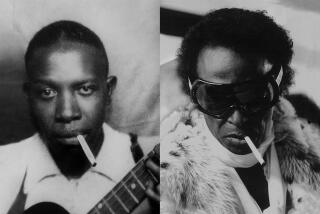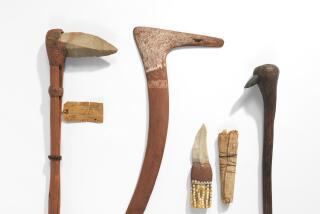Museum Given Major Collection of Egyptian Art : * Antiquities: The works donated by a La Jolla couple span 4,000 years and bring the Museum of Man the first mummies of its own.
- Share via
SAN DIEGO — A major collection of Egyptian antiquities has been donated to the San Diego Museum of Man, the museum said Wednesday.
Donated by Dr. Jeffrey A. Smith and Janet Bowden Smith of La Jolla, the collection of mummy and coffin masks, wooden shrines, mortuary vessels, amulets and figurines was given in honor of Smith’s father, Gerald A. Smith, founder and director emeritus of the San Bernardino County Museum.
The collection includes more than 200 objects from pre-dynastic times through the Islamic period, covering more than 4,000 years.
“It fits in beautifully with the original contribution donated by Ellen Browning Scripps,” museum director Douglas Sharon said, referring to works given to the museum in the 1920s and ‘30s that were found during an excavation of an 18th Dynasty city in Tel el Amarna. “Some of the pieces match up beautifully with the earlier donation.”
Three shrines with falcon mummies are a highlight of the new collection, the first Egyptian mummies officially in the museum’s collection. Two Egyptian mummies that have long been on view at the museum are on loan from the Los Angeles County Natural History Museum.
“The plan of when we will exhibit the collection is kind of nebulous still, since we just received them,” said Rose Tyson, curator of physical anthropology at the museum.
“The gift was made in December, and we had a meeting this morning to start formulating plans for an exhibit. We may put a select number on exhibit soon in our ‘new donations’ cases. Then we will start planning for a (permanent) exhibition.”
Bruce Kamerling, curator of collections for San Diego history at the San Diego Historical Society, helped facilitate the donation to the Museum of Man. Because of Kamerling’s early training in Egyptian antiquities, he had worked with the Smiths on translations of hieroglyphs in their collection, and he knows the works well.
Kamerling said the Scripps collection contains mostly everyday objects, while the Smith donation is primarily funerary objects, some of them noteworthy for their aesthetic as well as historic value.
“Some of the mummy masks are really outstanding,” Kamerling said. “In Egypt, everyone who could possibly afford to wanted to be mummified. The works in this collection represent a cross-section of economic types.”
More to Read
The biggest entertainment stories
Get our big stories about Hollywood, film, television, music, arts, culture and more right in your inbox as soon as they publish.
You may occasionally receive promotional content from the Los Angeles Times.










